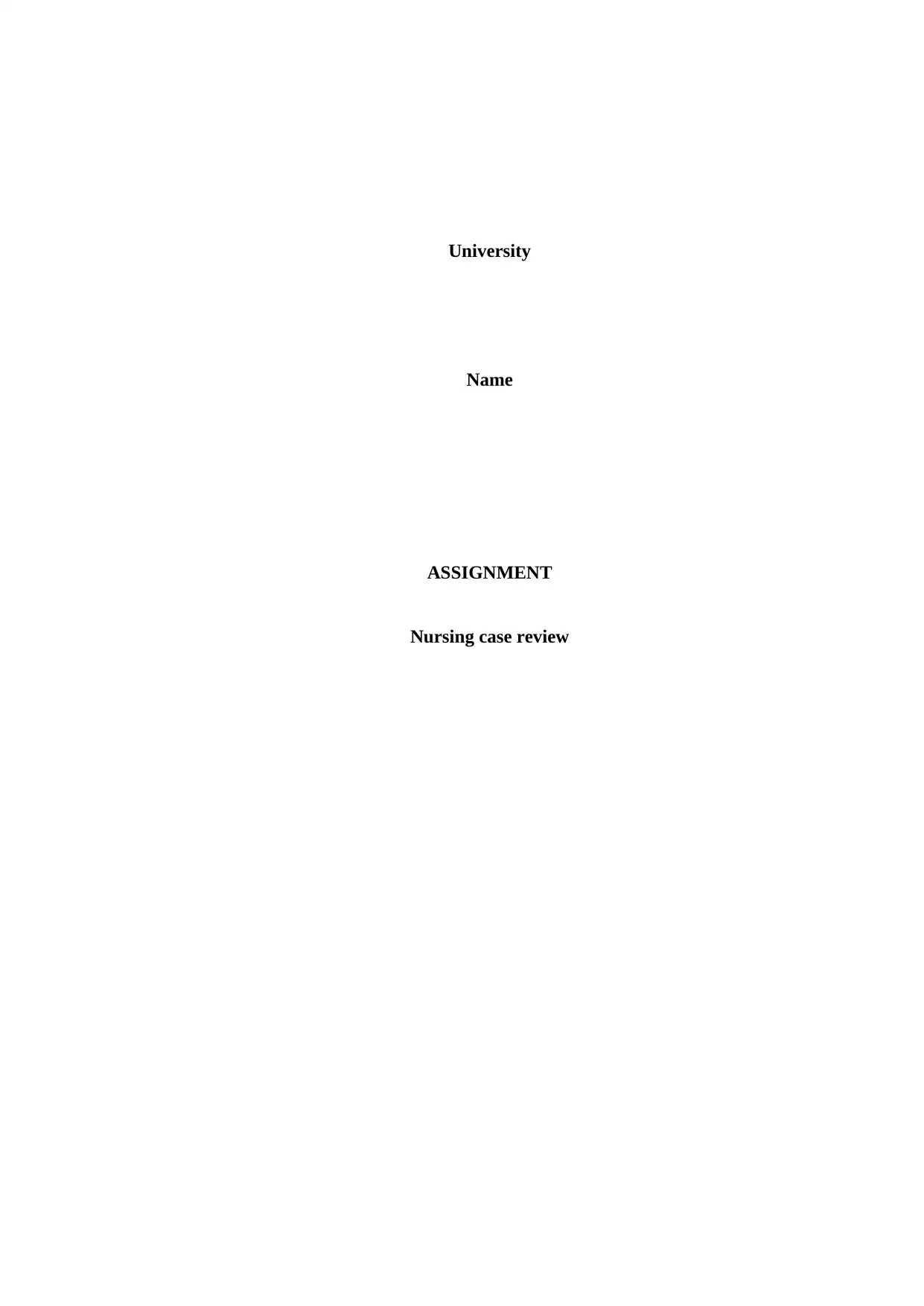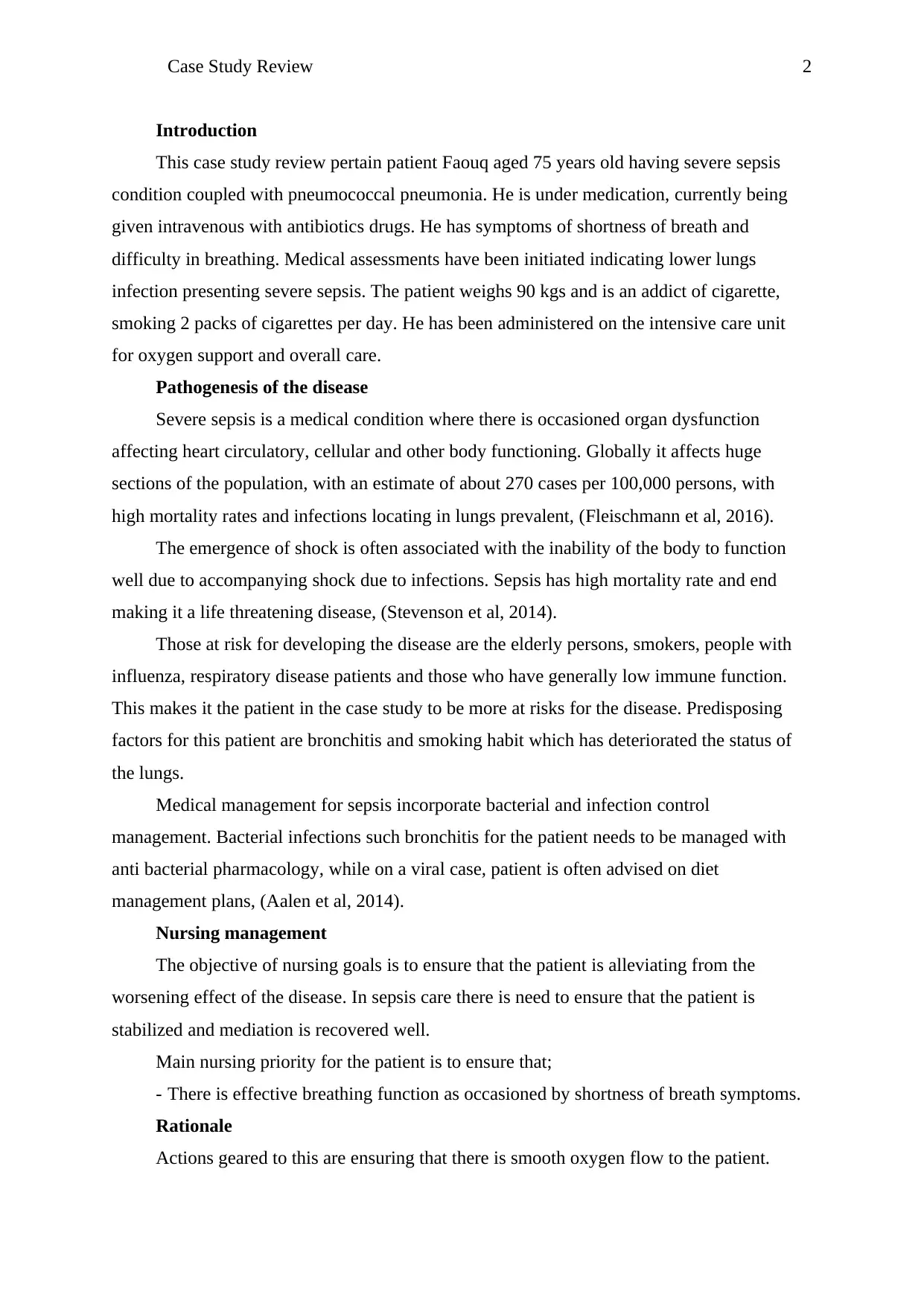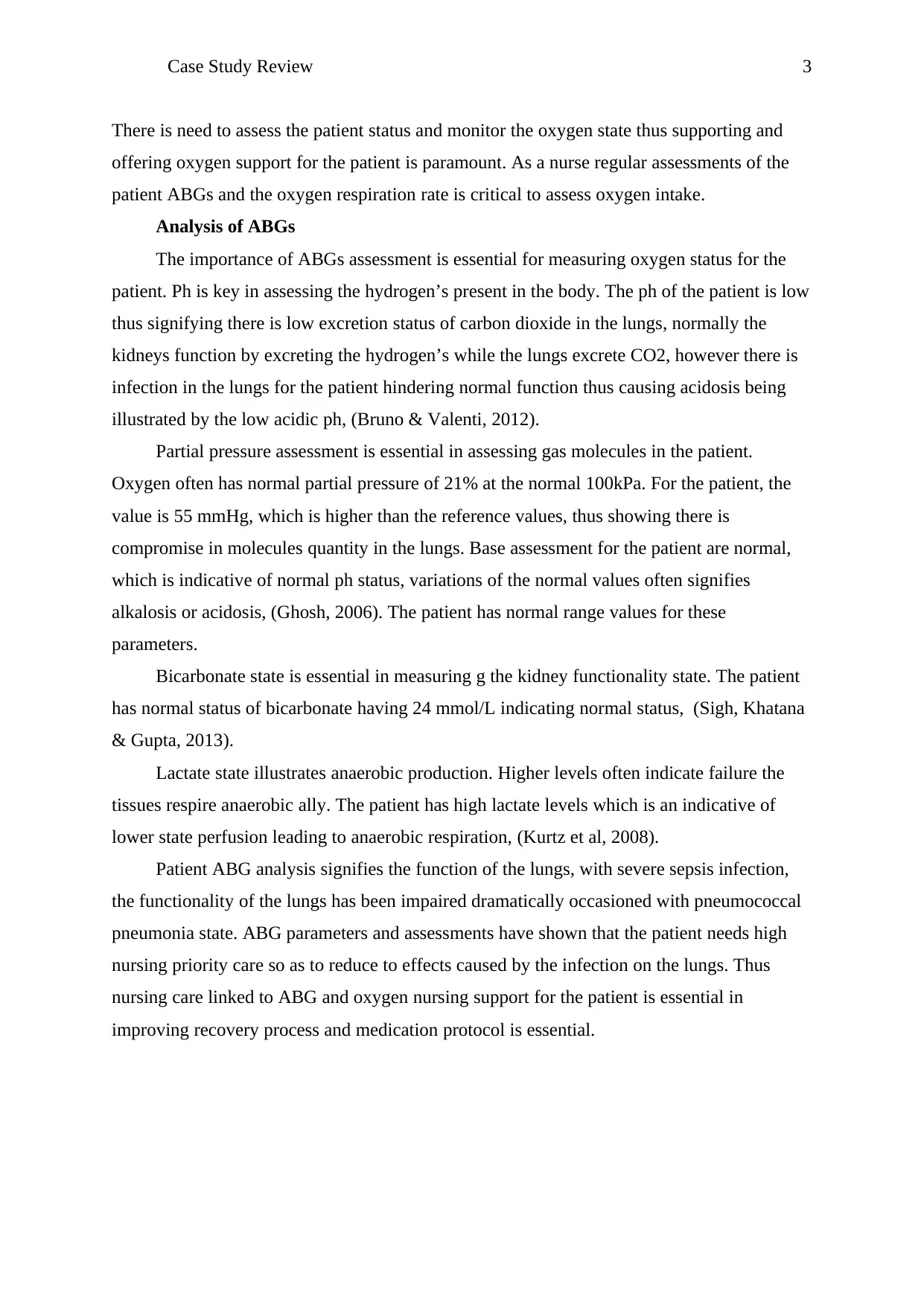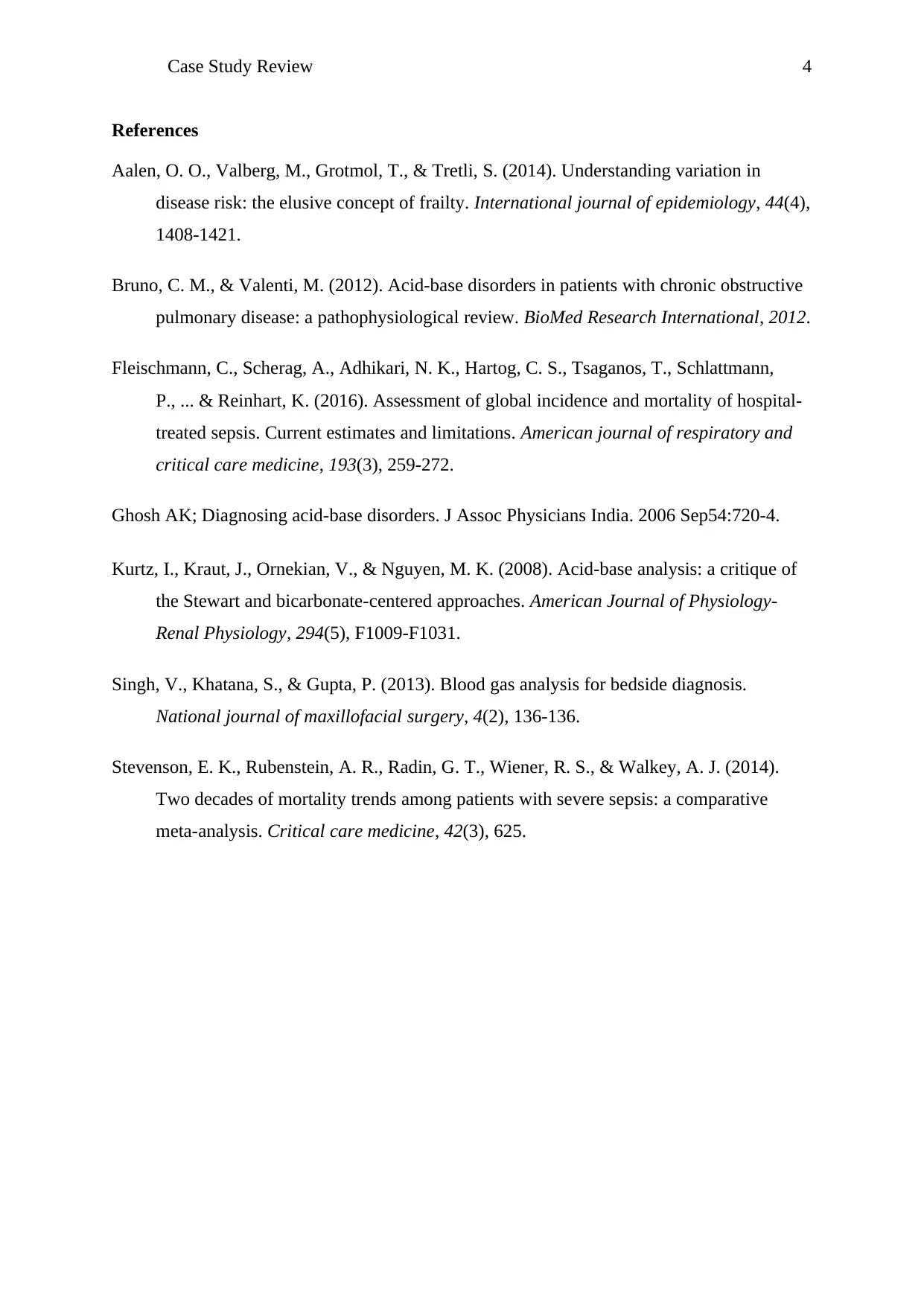Nursing Case Review: Severe Sepsis with Pneumococcal Pneumonia
VerifiedAdded on 2023/06/14
|4
|1133
|287
AI Summary
This nursing case review discusses the pathogenesis, medical and nursing management of a patient with severe sepsis and pneumococcal pneumonia. Learn about ABG analysis and nursing priorities.
Contribute Materials
Your contribution can guide someone’s learning journey. Share your
documents today.

University
Name
ASSIGNMENT
Nursing case review
Name
ASSIGNMENT
Nursing case review
Secure Best Marks with AI Grader
Need help grading? Try our AI Grader for instant feedback on your assignments.

Case Study Review 2
Introduction
This case study review pertain patient Faouq aged 75 years old having severe sepsis
condition coupled with pneumococcal pneumonia. He is under medication, currently being
given intravenous with antibiotics drugs. He has symptoms of shortness of breath and
difficulty in breathing. Medical assessments have been initiated indicating lower lungs
infection presenting severe sepsis. The patient weighs 90 kgs and is an addict of cigarette,
smoking 2 packs of cigarettes per day. He has been administered on the intensive care unit
for oxygen support and overall care.
Pathogenesis of the disease
Severe sepsis is a medical condition where there is occasioned organ dysfunction
affecting heart circulatory, cellular and other body functioning. Globally it affects huge
sections of the population, with an estimate of about 270 cases per 100,000 persons, with
high mortality rates and infections locating in lungs prevalent, (Fleischmann et al, 2016).
The emergence of shock is often associated with the inability of the body to function
well due to accompanying shock due to infections. Sepsis has high mortality rate and end
making it a life threatening disease, (Stevenson et al, 2014).
Those at risk for developing the disease are the elderly persons, smokers, people with
influenza, respiratory disease patients and those who have generally low immune function.
This makes it the patient in the case study to be more at risks for the disease. Predisposing
factors for this patient are bronchitis and smoking habit which has deteriorated the status of
the lungs.
Medical management for sepsis incorporate bacterial and infection control
management. Bacterial infections such bronchitis for the patient needs to be managed with
anti bacterial pharmacology, while on a viral case, patient is often advised on diet
management plans, (Aalen et al, 2014).
Nursing management
The objective of nursing goals is to ensure that the patient is alleviating from the
worsening effect of the disease. In sepsis care there is need to ensure that the patient is
stabilized and mediation is recovered well.
Main nursing priority for the patient is to ensure that;
- There is effective breathing function as occasioned by shortness of breath symptoms.
Rationale
Actions geared to this are ensuring that there is smooth oxygen flow to the patient.
Introduction
This case study review pertain patient Faouq aged 75 years old having severe sepsis
condition coupled with pneumococcal pneumonia. He is under medication, currently being
given intravenous with antibiotics drugs. He has symptoms of shortness of breath and
difficulty in breathing. Medical assessments have been initiated indicating lower lungs
infection presenting severe sepsis. The patient weighs 90 kgs and is an addict of cigarette,
smoking 2 packs of cigarettes per day. He has been administered on the intensive care unit
for oxygen support and overall care.
Pathogenesis of the disease
Severe sepsis is a medical condition where there is occasioned organ dysfunction
affecting heart circulatory, cellular and other body functioning. Globally it affects huge
sections of the population, with an estimate of about 270 cases per 100,000 persons, with
high mortality rates and infections locating in lungs prevalent, (Fleischmann et al, 2016).
The emergence of shock is often associated with the inability of the body to function
well due to accompanying shock due to infections. Sepsis has high mortality rate and end
making it a life threatening disease, (Stevenson et al, 2014).
Those at risk for developing the disease are the elderly persons, smokers, people with
influenza, respiratory disease patients and those who have generally low immune function.
This makes it the patient in the case study to be more at risks for the disease. Predisposing
factors for this patient are bronchitis and smoking habit which has deteriorated the status of
the lungs.
Medical management for sepsis incorporate bacterial and infection control
management. Bacterial infections such bronchitis for the patient needs to be managed with
anti bacterial pharmacology, while on a viral case, patient is often advised on diet
management plans, (Aalen et al, 2014).
Nursing management
The objective of nursing goals is to ensure that the patient is alleviating from the
worsening effect of the disease. In sepsis care there is need to ensure that the patient is
stabilized and mediation is recovered well.
Main nursing priority for the patient is to ensure that;
- There is effective breathing function as occasioned by shortness of breath symptoms.
Rationale
Actions geared to this are ensuring that there is smooth oxygen flow to the patient.

Case Study Review 3
There is need to assess the patient status and monitor the oxygen state thus supporting and
offering oxygen support for the patient is paramount. As a nurse regular assessments of the
patient ABGs and the oxygen respiration rate is critical to assess oxygen intake.
Analysis of ABGs
The importance of ABGs assessment is essential for measuring oxygen status for the
patient. Ph is key in assessing the hydrogen’s present in the body. The ph of the patient is low
thus signifying there is low excretion status of carbon dioxide in the lungs, normally the
kidneys function by excreting the hydrogen’s while the lungs excrete CO2, however there is
infection in the lungs for the patient hindering normal function thus causing acidosis being
illustrated by the low acidic ph, (Bruno & Valenti, 2012).
Partial pressure assessment is essential in assessing gas molecules in the patient.
Oxygen often has normal partial pressure of 21% at the normal 100kPa. For the patient, the
value is 55 mmHg, which is higher than the reference values, thus showing there is
compromise in molecules quantity in the lungs. Base assessment for the patient are normal,
which is indicative of normal ph status, variations of the normal values often signifies
alkalosis or acidosis, (Ghosh, 2006). The patient has normal range values for these
parameters.
Bicarbonate state is essential in measuring g the kidney functionality state. The patient
has normal status of bicarbonate having 24 mmol/L indicating normal status, (Sigh, Khatana
& Gupta, 2013).
Lactate state illustrates anaerobic production. Higher levels often indicate failure the
tissues respire anaerobic ally. The patient has high lactate levels which is an indicative of
lower state perfusion leading to anaerobic respiration, (Kurtz et al, 2008).
Patient ABG analysis signifies the function of the lungs, with severe sepsis infection,
the functionality of the lungs has been impaired dramatically occasioned with pneumococcal
pneumonia state. ABG parameters and assessments have shown that the patient needs high
nursing priority care so as to reduce to effects caused by the infection on the lungs. Thus
nursing care linked to ABG and oxygen nursing support for the patient is essential in
improving recovery process and medication protocol is essential.
There is need to assess the patient status and monitor the oxygen state thus supporting and
offering oxygen support for the patient is paramount. As a nurse regular assessments of the
patient ABGs and the oxygen respiration rate is critical to assess oxygen intake.
Analysis of ABGs
The importance of ABGs assessment is essential for measuring oxygen status for the
patient. Ph is key in assessing the hydrogen’s present in the body. The ph of the patient is low
thus signifying there is low excretion status of carbon dioxide in the lungs, normally the
kidneys function by excreting the hydrogen’s while the lungs excrete CO2, however there is
infection in the lungs for the patient hindering normal function thus causing acidosis being
illustrated by the low acidic ph, (Bruno & Valenti, 2012).
Partial pressure assessment is essential in assessing gas molecules in the patient.
Oxygen often has normal partial pressure of 21% at the normal 100kPa. For the patient, the
value is 55 mmHg, which is higher than the reference values, thus showing there is
compromise in molecules quantity in the lungs. Base assessment for the patient are normal,
which is indicative of normal ph status, variations of the normal values often signifies
alkalosis or acidosis, (Ghosh, 2006). The patient has normal range values for these
parameters.
Bicarbonate state is essential in measuring g the kidney functionality state. The patient
has normal status of bicarbonate having 24 mmol/L indicating normal status, (Sigh, Khatana
& Gupta, 2013).
Lactate state illustrates anaerobic production. Higher levels often indicate failure the
tissues respire anaerobic ally. The patient has high lactate levels which is an indicative of
lower state perfusion leading to anaerobic respiration, (Kurtz et al, 2008).
Patient ABG analysis signifies the function of the lungs, with severe sepsis infection,
the functionality of the lungs has been impaired dramatically occasioned with pneumococcal
pneumonia state. ABG parameters and assessments have shown that the patient needs high
nursing priority care so as to reduce to effects caused by the infection on the lungs. Thus
nursing care linked to ABG and oxygen nursing support for the patient is essential in
improving recovery process and medication protocol is essential.

Case Study Review 4
References
Aalen, O. O., Valberg, M., Grotmol, T., & Tretli, S. (2014). Understanding variation in
disease risk: the elusive concept of frailty. International journal of epidemiology, 44(4),
1408-1421.
Bruno, C. M., & Valenti, M. (2012). Acid-base disorders in patients with chronic obstructive
pulmonary disease: a pathophysiological review. BioMed Research International, 2012.
Fleischmann, C., Scherag, A., Adhikari, N. K., Hartog, C. S., Tsaganos, T., Schlattmann,
P., ... & Reinhart, K. (2016). Assessment of global incidence and mortality of hospital-
treated sepsis. Current estimates and limitations. American journal of respiratory and
critical care medicine, 193(3), 259-272.
Ghosh AK; Diagnosing acid-base disorders. J Assoc Physicians India. 2006 Sep54:720-4.
Kurtz, I., Kraut, J., Ornekian, V., & Nguyen, M. K. (2008). Acid-base analysis: a critique of
the Stewart and bicarbonate-centered approaches. American Journal of Physiology-
Renal Physiology, 294(5), F1009-F1031.
Singh, V., Khatana, S., & Gupta, P. (2013). Blood gas analysis for bedside diagnosis.
National journal of maxillofacial surgery, 4(2), 136-136.
Stevenson, E. K., Rubenstein, A. R., Radin, G. T., Wiener, R. S., & Walkey, A. J. (2014).
Two decades of mortality trends among patients with severe sepsis: a comparative
meta-analysis. Critical care medicine, 42(3), 625.
References
Aalen, O. O., Valberg, M., Grotmol, T., & Tretli, S. (2014). Understanding variation in
disease risk: the elusive concept of frailty. International journal of epidemiology, 44(4),
1408-1421.
Bruno, C. M., & Valenti, M. (2012). Acid-base disorders in patients with chronic obstructive
pulmonary disease: a pathophysiological review. BioMed Research International, 2012.
Fleischmann, C., Scherag, A., Adhikari, N. K., Hartog, C. S., Tsaganos, T., Schlattmann,
P., ... & Reinhart, K. (2016). Assessment of global incidence and mortality of hospital-
treated sepsis. Current estimates and limitations. American journal of respiratory and
critical care medicine, 193(3), 259-272.
Ghosh AK; Diagnosing acid-base disorders. J Assoc Physicians India. 2006 Sep54:720-4.
Kurtz, I., Kraut, J., Ornekian, V., & Nguyen, M. K. (2008). Acid-base analysis: a critique of
the Stewart and bicarbonate-centered approaches. American Journal of Physiology-
Renal Physiology, 294(5), F1009-F1031.
Singh, V., Khatana, S., & Gupta, P. (2013). Blood gas analysis for bedside diagnosis.
National journal of maxillofacial surgery, 4(2), 136-136.
Stevenson, E. K., Rubenstein, A. R., Radin, G. T., Wiener, R. S., & Walkey, A. J. (2014).
Two decades of mortality trends among patients with severe sepsis: a comparative
meta-analysis. Critical care medicine, 42(3), 625.
1 out of 4
Related Documents
Your All-in-One AI-Powered Toolkit for Academic Success.
+13062052269
info@desklib.com
Available 24*7 on WhatsApp / Email
![[object Object]](/_next/static/media/star-bottom.7253800d.svg)
Unlock your academic potential
© 2024 | Zucol Services PVT LTD | All rights reserved.





